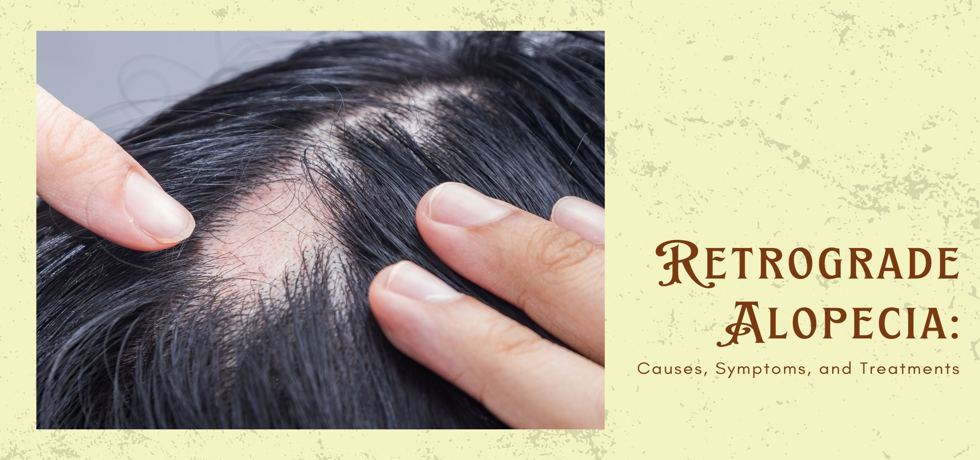
Understanding Retrograde Alopecia: Causes, Symptoms, and Solutions
Introduction to Retrograde Alopecia
Retrograde alopecia is a unique form of hair loss that is often lesser-known yet significantly impacts those affected by it. Unlike more familiar types of hair loss, retrograde alopecia primarily affects the nape of the neck and areas above the ears. Understanding this conditionits causes, symptoms, and available solutionsis essential for those experiencing unusual hair loss patterns. At The Skin Artistry, we aim to provide you with the necessary insights to help you manage this condition effectively.
What is Retrograde Alopecia?
Retrograde alopecia represents a form of hair thinning that occurs mainly in areas typically resistant to other patterns of male balding. This condition leads to hair loss from the nape and regions above the ears, as well as occasional thinning on the sides of the scalp. The underlying causes are not fully understood but may involve hormonal influences similar to those governing androgenetic alopecia. As a result, individuals often report gradual hair thinning, which can be both distressing and confusing.
Identifying the Symptoms of Retrograde Alopecia
Typical symptoms of retrograde alopecia include noticeable thinning or loss of hair specifically in areas not usually affected by traditional balding. One may notice thinning near the nape of the neck or above the ears, which might not be apparent at first. Consult a dermatologist at The Skin Artistry if you’re noticing vertical thinning of hair. It’s always best to get a professional diagnosis if you suspect that you might be suffering from this condition.
Causes of Retrograde Alopecia
The exact etiology of retrograde alopecia remains largely unknown; however, it appears to be associated with genetic predisposition and hormonal changes. Genes contribute significantly to hair loss conditions, often leading to progressive thinning. Stress and environmental elements may catalyze the manifestation of symptoms, while hormonal fluctuations can play a critical role in hair follicle sensitivity. Recognizing these factors is vital for implementing preventive measures.
How is Retrograde Alopecia Different?
It is important to differentiate retrograde alopecia from other forms of hair loss such as alopecia areata or androgenetic alopecia. Unlike these conditions, which present with specific bald patches or a receding hairline, retrograde alopecia typically manifests as a uniform thinning in less common areas. This nuanced understanding helps in identifying suitable treatment options, as well as alleviating the psychological impact associated with this type of hair loss.
Effective Treatment Solutions
The treatment options for retrograde alopecia generally mirror those for androgenetic alopecia. Topical solutions, such as minoxidil, have been shown to promote hair growth by enhancing blood flow to affected follicles. Another option is oral medications, which can reduce hormone-induced hair loss. For more severe cases, hair transplant procedures could present a viable solution, enabling hair restoration in thinning areas. Patients are also encouraged to consider supportive treatments involving vitamins and a nutrient-rich diet as part of a holistic approach to managing conditions like retrograde alopecia.
Maintaining Hair and Scalp Health
Protecting your scalp and maintaining hair health is equally important when managing retrograde alopecia. Regular gentle cleansing, nourishing oils, and herbal treatments can foster an optimal environment for hair growth. Home remedies such as aloe vera, coconut oil, and natural masks can provide soothing effects and potentially stimulate hair follicle activity. Coupled with medical consultations, these lifestyle adjustments can vastly improve your overall hair condition.
Conclusion and Actionable Steps
If you find yourself grappling with unexplained hair loss near the nape of your neck or above your ears, it may be time to explore the possibility of retrograde alopecia. A combination of medical treatments and lifestyle modifications can result in meaningful improvements. At The Skin Artistry, we recommend consulting with one of our expert dermatologists to develop a personalized treatment plan tailored to your specific condition. Remember, tackling hair loss is a journey, and you are not alone.
For professional assistance and expert advice from leading dermatologists like Dr. Hital Patel, experience the benefits of managing retrograde alopecia with Hair & Skin Specialist Dr. Hital Patel at The Skin Artistry. Our clinics in PDPU Gandhinagar, Vastrapur Ahmedabad, and Hyderabad (Visiting Consultant) offer top-quality care and personalized treatments. Visit us today to learn more about our services and take advantage of our special offers! For more insights, updates, or to collaborate, stay connected with The Skin Artistry.

